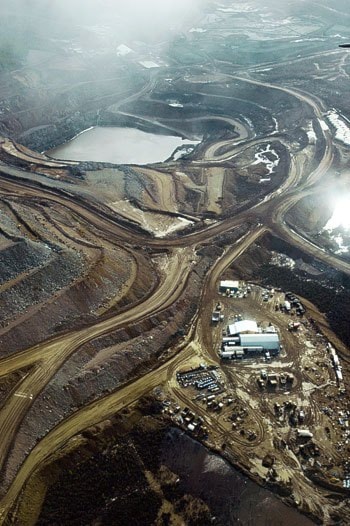Minto mine wants its water licence diluted.
Capstone Mining Corp. is asking the Yukon Environmental and Socio-Economic Assessment Board to lower the water quality standards the copper mine must meet.
The mine’s current licence, which predates both Capstone’s ownership of the property and Yukon’s current regulatory regime, has standards that are “arbitrary” and unhelpful to the company and the environment alike, said Capstone president Stephen Quin.
The watershed surrounding the mine naturally contains high levels of metals, said Quin - so much so that creeks unaffected by mining operations exceed Minto’s water-quality standards.
“It’s kind of a perverse system. We take clean water - let’s call it natural water -Â and we clean it all up to drinking water standards, or better. And then we dump it 50 metres downstream, into a creek of dirty water.
“By dirty, I mean natural runoff. You look at the Yukon River during runoff and it’s brown. We take it out, we make it crystal clear and, 50 metres later, we dump it into brown water.
“What’s the point? There’s no environmental benefit to it.”
The lower thresholds proposed by Capstone still exceed the federal government’s metal mining effluent regulations, said Quin.
But Lewis Rifkind, mining co-ordinator for the Yukon Conservation Society, is not persuaded.
“Every time you put in a road, every time you dig a test pit, you start exposing minerals to runoff water, and over time it builds up. So who knows whether the background contamination is natural or not.
“Better to err on the side of caution and have really tough water standards so that water coming off the mine is as clean as possible.”
Minto also wants to redirect runoff away from the minesite. When the mine was licenced in the late 1990s, the big concern, based on available data, was that there would not be enough water for the mine to operate.
“The whole concept was to grab every bit of water and keep it,” said Quin.
This proved a big mistake. The past few years have been far wetter than expected. As a result, Minto has had to conduct three emergency discharges in the past two years.
This provided plenty of fodder for the mine’s critics. In September, the Selkirk Renewable Resources Committee called for the mine’s closure. The committee worried about the impact these emergency discharges might have on the Yukon River’s salmon.
It noted that Environment Canada expressed fears that the discharges would harm juvenile salmon found near the bend in the river where the mine discharges its water.
Copper is a particularly dangerous metal to salmon. It damages their sense of smell. As a result, the fish have trouble navigating and avoiding predators.
But Yukon’s water board concluded the discharges would be safe for fish. And, Quin notes, these discharges still had to meet the Ottawa’s mining water standards.
Rifkind supports the mine’s plan “to keep clean water clean,” but fears some diverted water may pass over disturbed areas, picking up contamination along the way. He’d like to see studies that show the water quality of this runoff.
The mine also plans to build a new water-treatment plant, at a cost of approximately $2.5 million, that should be capable of processing 4,000 litres per day. That’s more than a four-fold improvement over the existing plant, which bogged down at times under the strain of the past year’s deluge.
The new plant will be delivered to site in February and running before spring runoff, said Quin.
Bob Wagner of Keno City worries the current review of the mine’s water-management plan overlooks bigger problems. He thinks the mine’s water treatment pond is too small.
“That won’t be answered by this assessment process, because they won’t look at it,” he said.
True enough, said Loralee Johnstone, manager of the assessment board’s Mayo office.
The board is not empowered to redesign a mine that’s already up and running, she said.
“We don’t have the ability. It’s their project. We assess what’s proposed.”
The assessment board began seeking public comments on the proposal on December 9. As of Tuesday afternoon, it had received only one submission, from the Selkirk Renewable Resources Council, requesting that the deadline for comments be extended from January 13 until January 31.
Minto, located 240 kilometres northwest of Whitehorse, is currently Yukon’s only operating hardrock mine.
Contact John Thompson at
johnt@yukon-news.com.
